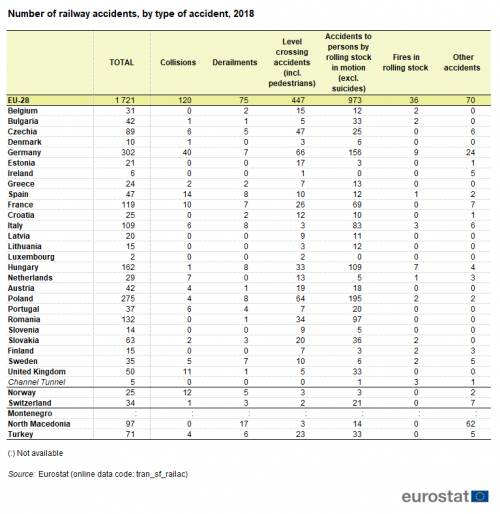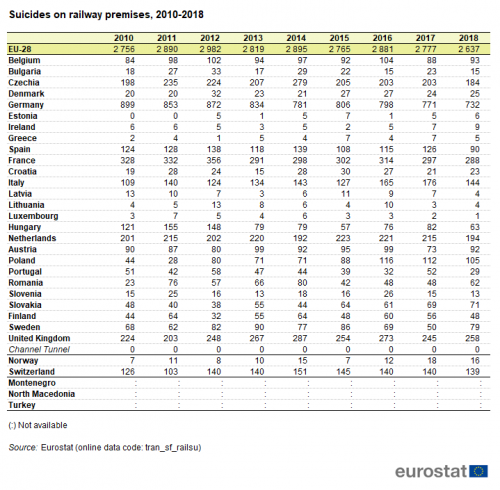Archive:Rail accident fatalities in the EU
Data from December 2019
Planned article update: January 2021
Highlights
In 2018, there were 1 726 significant railway accidents in the EU, with a total of 887 fatalities and 762 persons seriously injured.
There were 567 fewer significant railway accidents in 2018 compared with 2010, a reduction of 25 %.
In 2018, almost two thirds of fatalities from railway accidents in the EU involved unauthorised persons on the tracks (64 %) and around a third occurred at level crossings (29 %).
Number of injured persons in railway accidents in the EU, by category of person, 2010-2018
In 2018, 1 726 significant railway accidents were reported in the EU-28. A total of 887 persons were killed in these accidents, while another 762 persons were seriously injured. At EU level, the number of fatalities in railway accidents decreased gradually from 1 270 in 2010 to 887 in 2018.
Suicides occurring on the railways are reported separately. With 2 637 reported cases in 2018, suicides outnumber the victims accounted for by railway accidents.
Eurostat publishes data collected by the European Railway Agency (ERA) in Eurobase. This information is also published by ERA.
Full article
Fall in the number of railway accidents
6.6 % fewer railway accidents in the EU-28 in 2018 compared to 2017
The number of significant railway accidents fell between 2010 and 201, with the exception of two increases in 2014 and 2017. In 2018, the number of accidents decreased by 122 accidents compared to 2017, to a total of 1 726 accidents (-6.6 %) (Figure 1).Railway safety has generally improved in the EU, with 567 fewer accidents in 2018 compared to 2010, a reduction of 24.7 %. In 2015, the decrease compared with the previous year was particularly marked (-13.1 %). In 2017, however, the number of significant accidents was slightly above the level of 2015. The decrease in accidents from 2017 to 2018 did not concern all accident categories: while the number of level crossing accidents (-19 accidents), derailments (-23 accidents), accidents to persons by rolling stock in motion (excl. suicides) (-99 accidents) and other significant railway accidents (-5 accidents) all decreased in 2018 compared to 2017, the number of collisions (+6 accidents) and fires in rolling stock (+18 accidents) increased.
Accident figures are comparable from 2010 onwards, following the implementation of common definitions across all Member States. Prior to 2010, Belgium, Poland and Slovakia generally reported all railway accidents instead of only significant accidents. As a result, there was a lower number of accidents in several categories from 2010 onwards compared to previous years.
Looking at the detailed 2018 figures on significant railway accidents (Table 1), the largest category at EU level was accidents to persons caused by rolling stock in motion, with 974 accidents representing 56 % of the total. Typically, these accidents involve persons on railway tracks (unauthorised persons or trespassers) that are hit by a running train. Accidents at level crossings, including pedestrians, is the other main category, with a total number of 447 accidents in 2018 (26 % of the total). Together, these two categories represented 82 % of the total number of railway accidents in the EU.
Table 1 also shows that Germany, followed by Poland, registered the highest number of railway accidents among the Member States in 2018; together these two countries recorded one third of all significant railway accidents in the EU. With 162 accidents, Hungary accounted for 9 % of the railway accidents in the EU. In contrast, Luxembourg reported only two significant railway accidents in 2018 (two accidents to persons caused by level crossing accidents) and Ireland six accidents (one accident to persons caused by level crossing accidents and five other type of accidents).
Persons killed in railway accidents
More than 60 % of the persons killed in railway accidents in 2018 were unauthorised persons on railway premises
Figure 2 shows the number of persons killed in railway accidents in the EU for each reference year from 2010 to 2018. The total number of fatalities gradually declined from 1 270 persons killed in railway accidents in 2010 to 971 persons in 2015. In the years 2016 and 2017, the fatalities remained roughly at the same level as in 2015, falling slightly to 970 persons killed in 2016 but increasing to 974 persons killed in 2017. In 2018, a decrease of 8.9% was recorded with 887 persons killed, 87 persons less than the previous year. Over the period from 2010 to 2018, this corresponds to a reduction in the number of persons killed in railway accidents by almost one third (-30.2 %).
Focusing on 2018, fatalities in the category “Unauthorised persons” (Table 2) remained the largest category of victims, with 569 cases in 2018 (64.1 % of the total number of persons killed in railway accidents). The second largest category was “Level crossing users” with 257 deaths (29 %). Only a fraction of the registered fatalities were railway passengers. In most of the years for which harmonised data are available (2010 onwards), railway passenger fatalities represented only a marginal share (1-3 %) of the persons killed. The exception was 2013, when the 97 railway passengers killed in accidents represented almost 9 % of the total fatalities. This was solely attributable to a railway accident in Santiago de Compostela in July 2013. The 79 fatalities from this accident represented all Spain’s fatalities in the category “Railway passengers” and 81 % of the fatalities in that category in the EU-28 in 2013. In 2018, the share of railway passengers in the total number of fatalities was 2 % (18 railway passengers killed).
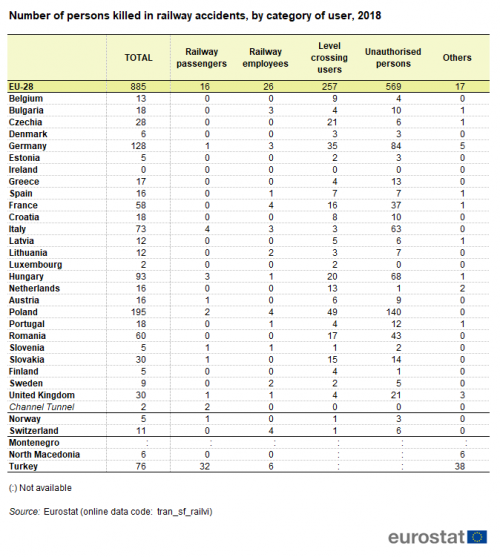
Source: Eurostat (tran_sf_railvi)
The overall trends in the data show that railway travel is increasingly safe, with few fatalities among rail passengers. The ERA estimated that for the period 2010-2014, the fatality risk for passengers travelling on trains was 0.14 fatalities per billion train-kilometres at EU level, one third lower than for a bus/coach passenger but at least twice as high as for a commercial aircraft passenger (For further details, see ERA’s annual publication on “Railway Safety Performance in the European Union”). However, it should be noted that there are substantial differences between Member States, with the risk for railway passengers in some Member States significantly higher than the EU average.
Causes of railway accident fatalities
Most fatalities from railway accidents occur at level crossings or involve unauthorised persons on the tracks
Table 3 outlines the fatalities from railway accidents according to the type of accident. In 2018, more than two thirds of the fatalities in the EU (68.8 % of the total) were caused by “Accidents to persons by rolling stock in motion”, typically involving persons that are unauthorised on the railway tracks and are hit by a running train. Together with level-crossing accidents (29.1 %), these two accident types were responsible for almost 98 % of all deaths occurring on railways in the EU in 2018.
The number of persons killed in accidents to persons by rolling stock in motion was particularly high in Poland (146 fatalities) and Germany (91 fatalities), in both countries roughly three quarters of the persons killed in railway accidents in the country. With 72 fatalities, relative to its size also Hungary recorded a high number of persons killed in accidents to persons by rolling stock in motion.
Fewer persons seriously injured in railway accidents
Significant reduction in persons seriously injured in railway accidents since 2010, especially for railway passengers
Over the period 2010-2018, the number of persons seriously injured in railway accidents at EU level fell for all categories of persons (Figure 3). This trend is noticeable despite occasional year-to-year fluctuations. Whereas the average annual decrease in the total number of seriously injured persons averaged 11.4 % per year from 2010 to 2015, in 2016 an increase of 21% in the number of injured persons was observed. The high number of injured railway passengers registered in 2010 was due to the severe train collision at Buizingen (Belgium), with 171 persons seriously injured. In 2016, the number of injured passengers registered a significant increase compared to the previous year, before falling again in 2017 and remaining stable in 2018.
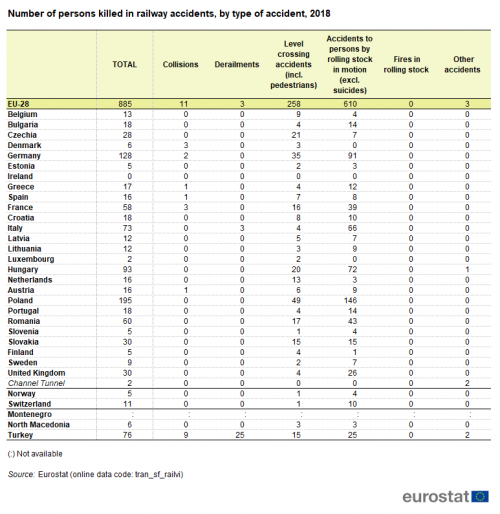
Source: Eurostat (tran_sf_railvi)
Focusing on the year 2018, Table 4 illustrates that the pattern of the various accident categories is directly reflected in the number of persons injured in the different types of accidents. Most persons seriously injured were counted in accidents involving rolling stock in motion (377 injured persons, or 49.5 % of the total) followed by level crossing accidents (291 persons, or 38.2 %).
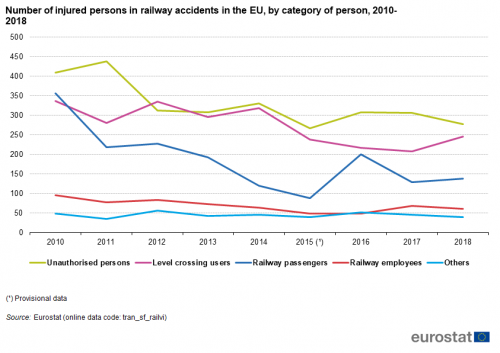
Source: Eurostat (tran_sf_railvi)
Far fewer persons were injured in the other types of accidents. Train collisions seriously injured 37 persons in 2018, half less than previous year. In 16 Member States, no persons were seriously injured in train collisions in 2018. Overall in the EU, there were 36 persons seriously injured in derailments in 2018, with 34 persons in Italy, one person in Romania and one person in Slovakia. Germany (68 persons seriously injured), Romania (54 persons) and Poland (49 persons) recorded the highest numbers of persons injured in accidents to persons by rolling stock in motion. It should be noted that the comparison of seriously injured persons between countries may be slightly biased due to differences in reporting regimes.

Source: Eurostat (tran_sf_railvi)
Suicides on railways
Suicides occurring on the railways by far outnumber the number of persons killed and seriously injured in accidents
Suicides occurring on the railways are reported separately from the persons killed or injured in railway accidents. For the EU as a whole, the number of such suicides remained at between 2 600 and 3 000 each year in the period 2010-2018. The highest number was recorded in 2012 with 2 982 suicides on railway premises. In the following years, the numbers fluctuated, changing by between -5.5 % to +4.9 % year-on-year. In 2018, 2 637 suicides were reported, 5 % fewer than in the previous year. The number of suicides on railway premises is significant in most of the Member States. With 732 recorded suicides in 2018, Germany alone accounted for over one quarter (27.8 %) of these suicides recorded in the EU. There were also significant number of such suicides in France (288 recorded cases), the United Kingdom (258 recorded cases), the Netherlands (194 recorded cases) and Czechia (184 recorded cases).
It is not easy to address measures aimed at preventing suicides from occurring on the railways. Barriers are often built at hotspots and railway station personnel are given training to tackle attempted suicides.
Source data for tables and graphs
Data sources
The sources used for the statistics in this publication are data reported to the European Union Agency for Railways (ERA). Railway safety data have been collected by ERA since 2006 through the Common Safety Indicators (CSIs). These were introduced by Annex I of the Railway Safety Directive (Directive 2004/49/EC). Member States have a legal obligation to submit their CSI data to the ERA. ERA publishes an overview of safety-related CSIs as soon as data have been consolidated. The CSIs data are reported via and available through the ERAIL system. The full set of CSI data is made available in the annually published Railway Safety Performance Report. Accident figures are reliable from 2010 onwards, following the strict application of standard definitions. In the past, Belgium, Poland and Slovakia typically reported all railway accidents instead of significant accidents only. This meant a lower count in several categories of accidents since 2010.
Eurostat has signed an agreement with ERA to disseminate these railway safety data through Eurobase. The data disseminated by Eurostat constitute a subset of the data available at ERA.
Railway accident data were also collected through Annex H providing for statistical returns on railway traffic and transport (Regulation (EC) No 91/2003). This Regulation has been recast and replaced by Regulation (EC) No 2018/643. The data collection through Annex H was phased out and replaced with the data collected by ERA. However, Montenegro, the Former Yugoslav Republic of Macedonia and Turkey continue to provide data according to Annex H of Regulation (EC) No 91/2003, as they do not have an agreement with ERA.
The railway accident data collected by ERA data are located in the “Horizontal multi-modal information (tran)” section under “Transport safety (tran_sf)” in Eurobase. Historic data based on Annex H can be found in the section “Railway transport - Accidents (rail_ac)”.
Some differences may occasionally exist between these data, as ERA handles its own compilation procedures and quality checks. Also, whereas data reported to ERA are provided by the national safety authorities, data reported to Eurostat under the framework of Regulation (EC) No 91/2003 were reported by the national statistical institutes. The NSIs might have depended on data from the same national safety authorities, but not necessarily.
Context
National rail networks have different technical specifications for infrastructure – gauge widths, electrification standards and safety and signalling systems – which make it more difficult and costly to run a train from one country to another. EU policies exist to overcome such differences. Creating an integrated European railway area thus requires better technical compatibility – 'interoperability' – of infrastructure, rolling stock, signalling and other subsystems of the rail system. Procedures for authorising the use of rolling stock across the EU's rail network also need to be simplified.
The European Union Agency for Railways (ERA) helps promoting interoperability and develop uniform technical standards, a process in which cooperation between EU countries and rail stakeholders is essential.
ERA, based in Lille/Valenciennes (France), is helping to build an integrated European railway area by improving rail safety and interoperability. Set up in 2006, it develops shared technical specifications and approaches to safety, working closely with stakeholders from the rail sector and national authorities, the EU institutions and other interested parties. Featuring a dedicated safety unit, the Agency also monitors and reports on rail safety in the EU.
Direct access to
Other articles
Database
- Transport, see:
- Multimodal data (tran)
- Transport safety (tran_sf)
- Rail transport safety (tran_sf_rail)
- Rail accidents by type of accident (ERA data) (tran_sf_railac)
- Rail accidents victims by type of accident (ERA data) (tran_sf_railvi)
- Rail accidents involving the transport of dangerous goods (ERA data) (tran_sf_raildg)
- Suicides involving railways (ERA data) (tran_sf_railsu)
- Rail transport safety (tran_sf_rail)
- Transport safety (tran_sf)
Data collected through Annex H of Regulation (EC) No 91/2003:
- Transport, see:
- Railway transport (rail)
- Railway transport – Accidents (rail_ac)
- Annual number of victims by type of accident (rail_ac_catvict)
- Annual number of accidents by type of accident (rail_ac_catnmbr)
- Annual number of accidents involving the transport of dangerous goods (rail_ac_dnggood)
- Railway transport – Accidents (rail_ac)
Methodology
Composition of EU aggregates
EU-28: European Union composed of 28 Member States: Belgium, Bulgaria, Czech Republic, Denmark, Germany, Estonia, Ireland, Greece, Spain, France, Croatia, Italy, Cyprus, Latvia, Lithuania, Luxembourg, Hungary, Malta, the Netherlands, Austria, Poland, Portugal, Romania, Slovenia, Slovakia, Finland, Sweden and the United Kingdom.
Cyprus, Malta and Iceland have no railways. Liechtenstein's railways, which are operated by ÖBB, are included in the Austrian data.
The tables include the Channel Tunnel as a separate entity, as data referring to railway accidents in the Channel Tunnel cannot be assigned to either France or the United Kingdom. EU aggregates include Channel Tunnel figures.
Data for Montenegro, the Former Yugoslav Republic of Macedonia and Turkey are extracted from Annex H of Regulation (EC) No 91/2003.
Some data for the most recent reference year may remain provisional for some time. This is linked to ongoing investigations and hence decisions whether to include or exclude certain accidents and or their categorisation.

